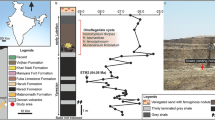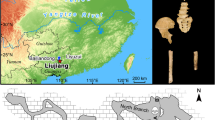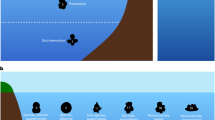Abstract
REPLYING TO G. Mayr & A. Manegold Nature 499, 10.1038/nature12367 (2013)
Our explanation that structures preserved in three Early Cretaceous Jehol birds1 are ovarian follicles is challenged by Mayr & Manegold2. We believe that their conclusions are speculative and do not take into account our original arguments. Contrary to Mayr & Manegold2, unambiguous evidence for the preservation of less resistant tissue, such as muscles or internal organs, are not scarce among Jehol fossils (for example, fish, lampreys)3 and eggs are sometimes preserved in specimens of the sturgeon Peipiaosteus (J.-Y. Zhang, personal communication). Although we cannot explain the vagaries of taphonomy that lead to the preservation of ovarian follicles in these specimens, what is clear is that exceptional preservation of soft tissue is dictated by the unique chemical microenvironment created by the individual decaying tissues, and thus varied degrees of preservation within a single specimen is expected4. Exceptional Jehol fossils are a reminder that simply because something is unlikely to preserve does not mean that it will not.
This is a preview of subscription content, access via your institution
Access options
Subscribe to this journal
Receive 51 print issues and online access
$199.00 per year
only $3.90 per issue
Buy this article
- Purchase on Springer Link
- Instant access to full article PDF
Prices may be subject to local taxes which are calculated during checkout
Similar content being viewed by others
References
Zheng, X. et al. Preservation of ovarian follicles reveals early evolution of avian reproductive behaviour. Nature 495, 507–511 (2013)
Mayr, G. & Manegold, A. Can ovarian follicles fossilize? Nature 499, http://dx.doi.org/10.1038/nature12367 (2013)
Zhou, Z. & Wang, Y. Vertebrate diversity of the Jehol Biota as compared with other lagerstätten. Sci. China Earth Sci. 53, 1894–1907 (2010)
Briggs, D. E. G., Wilby, P. R., Pérez-Moreno, B., Sanz, J. L. & Frenegal-Martinez, M. The mineralization of dinosaur soft tissue in the Lower Cretaceous of Las Hoyas, Spain. J. Geol. Soc. 154, 587–588 (1997)
Griffiths, P. J. in 1r Congrés Internacional sobre Ous i Cries de Dinosaures, Extended Abstracts (eds Bravo, A. M. & Reyes, T. ) 77–83 (Isona i Conca Dellà, 1999)
Chen, P.-J., Dong, Z. & Zhen, S. An exceptionally well-preserved theropod dinosaur from the Yixian Formation of China. Nature 391, 147–152 (1998)
Weiner, S., Lowenstam, H. A. & Hood, L. Characterization of 80-million-year-old mollusk shell proteins. Proc. Natl Acad. Sci. USA 73, 2541–2545 (1976)
Minnaar, P. & Minnaar, M. The Emu Farmer’s Handbook (Iduna Company, 1994)
Gill, F. B. Ornithology 3rd edn (W.H. Freeman and Company, 2007)
Zheng, X. et al. Fossil evidence of avian crops from the Early Cretaceous of China. Proc. Natl Acad. Sci. USA 108, 15904–15907 (2011)
Thorbjarnarson, J. B. Reproductive characteristics of the order Crocodylia. Herpetologica 52, 8–24 (1996)
Chinsamy, A., Chiappe, L. M. & Dodson, P. Mesozoic avian bone microstructure: physiological implications. Paleobiology 21, 561–574 (1995)
Dyke, G. D. & Kaiser, G. In Proceedings of the VII International Meeting of the Society of Avian Paleontology and Evolution Vol. 62 (eds Boles, W. E. & Worthy, T. H. ) 207–216 (Records of the Australian Museum, 2010)
Author information
Authors and Affiliations
Contributions
J.O., Z.Z. and X.Z. designed the research. J.O. and Z.Z. wrote the reply.
Corresponding author
Rights and permissions
About this article
Cite this article
O’Connor, J., Zheng, X. & Zhou, Z. Zheng et al. reply. Nature 499, E1–E2 (2013). https://doi.org/10.1038/nature12368
Published:
Issue Date:
DOI: https://doi.org/10.1038/nature12368
This article is cited by
-
Reanalysis of putative ovarian follicles suggests that Early Cretaceous birds were feeding not breeding
Scientific Reports (2020)
-
Early evolution of the biological bird: perspectives from new fossil discoveries in China
Journal of Ornithology (2015)
Comments
By submitting a comment you agree to abide by our Terms and Community Guidelines. If you find something abusive or that does not comply with our terms or guidelines please flag it as inappropriate.



